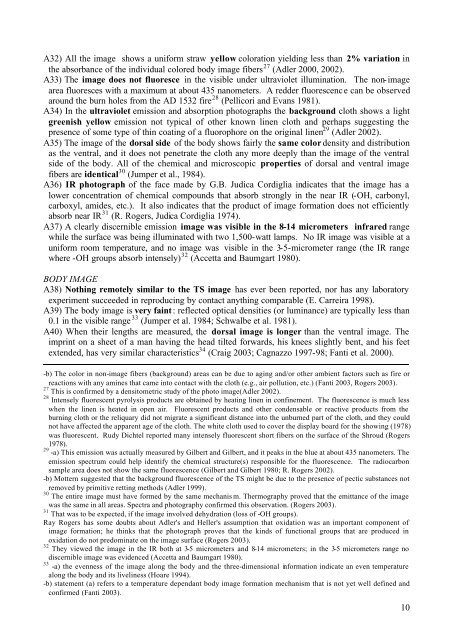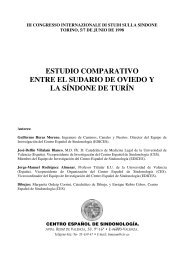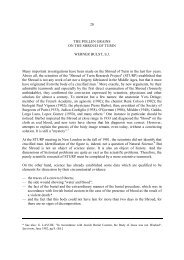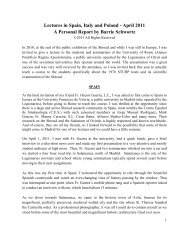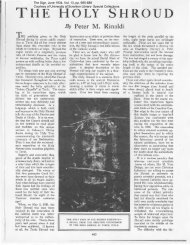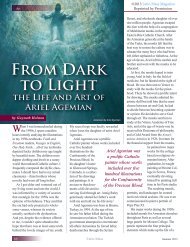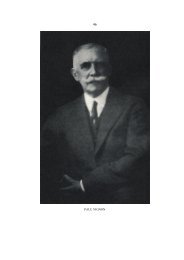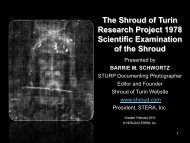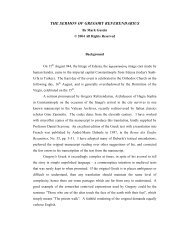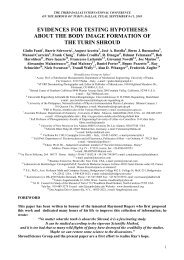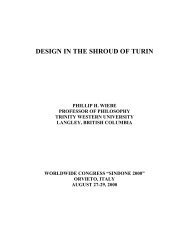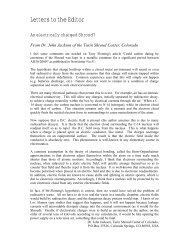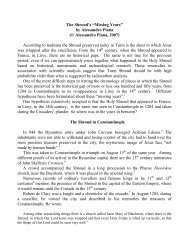list of evidences 10d Barrie - The Shroud of Turin Website
list of evidences 10d Barrie - The Shroud of Turin Website
list of evidences 10d Barrie - The Shroud of Turin Website
You also want an ePaper? Increase the reach of your titles
YUMPU automatically turns print PDFs into web optimized ePapers that Google loves.
A32) All the image shows a uniform straw yellow coloration yielding less than 2% variation inthe absorbance <strong>of</strong> the individual colored body image fibers 27 (Adler 2000, 2002).A33) <strong>The</strong> image does not fluoresce in the visible under ultraviolet illumination. <strong>The</strong> non-imagearea fluoresces with a maximum at about 435 nanometers. A redder fluorescence can be observedaround the burn holes from the AD 1532 fire 28 (Pellicori and Evans 1981).A34) In the ultraviolet emission and absorption photographs the background cloth shows a lightgreenish yellow emission not typical <strong>of</strong> other known linen cloth and perhaps suggesting thepresence <strong>of</strong> some type <strong>of</strong> thin coating <strong>of</strong> a fluorophore on the original linen 29 (Adler 2002).A35) <strong>The</strong> image <strong>of</strong> the dorsal side <strong>of</strong> the body shows fairly the same color density and distributionas the ventral, and it does not penetrate the cloth any more deeply than the image <strong>of</strong> the ventralside <strong>of</strong> the body. All <strong>of</strong> the chemical and microscopic properties <strong>of</strong> dorsal and ventral imagefibers are identical 30 (Jumper et al., 1984).A36) IR photograph <strong>of</strong> the face made by G.B. Judica Cordiglia indicates that the image has alower concentration <strong>of</strong> chemical compounds that absorb strongly in the near IR (-OH, carbonyl,carboxyl, amides, etc.). It also indicates that the product <strong>of</strong> image formation does not efficientlyabsorb near IR 31 (R. Rogers, Judica Cordiglia 1974).A37) A clearly discernible emission image was visible in the 8-14 micrometers infrared rangewhile the surface was being illuminated with two 1,500-watt lamps. No IR image was visible at auniform room temperature, and no image was visible in the 3-5-micrometer range (the IR rangewhere -OH groups absorb intensely) 32 (Accetta and Baumgart 1980).BODY IMAGEA38) Nothing remotely similar to the TS image has ever been reported, nor has any laboratoryexperiment succeeded in reproducing by contact anything comparable (E. Carreira 1998).A39) <strong>The</strong> body image is very faint: reflected optical densities (or luminance) are typically less than0.1 in the visible range 33 (Jumper et al. 1984; Schwalbe et al. 1981).A40) When their lengths are measured, the dorsal image is longer than the ventral image. <strong>The</strong>imprint on a sheet <strong>of</strong> a man having the head tilted forwards, his knees slightly bent, and his feetextended, has very similar characteristics 34 (Craig 2003; Cagnazzo 1997-98; Fanti et al. 2000).-b) <strong>The</strong> color in non-image fibers (background) areas can be due to aging and/or other ambient factors such as fire orreactions with any amines that came into contact with the cloth (e.g., air pollution, etc.) (Fanti 2003, Rogers 2003).27 This is confirmed by a densitometric study <strong>of</strong> the photo image(Adler 2002).28 Intensely fluorescent pyrolysis products are obtained by heating linen in confinement. <strong>The</strong> fluorescence is much lesswhen the linen is heated in open air. Fluorescent products and other condensable or reactive products from theburning cloth or the reliquary did not migrate a significant distance into the unburned part <strong>of</strong> the cloth, and they couldnot have affected the apparent age <strong>of</strong> the cloth. <strong>The</strong> white cloth used to cover the display board for the showing (1978)was fluorescent. Rudy Dichtel reported many intensely fluorescent short fibers on the surface <strong>of</strong> the <strong>Shroud</strong> (Rogers1978).29 -a) This emission was actually measured by Gilbert and Gilbert, and it peaks in the blue at about 435 nanometers. <strong>The</strong>emission spectrum could help identify the chemical structure(s) responsible for the fluorescence. <strong>The</strong> radiocarbonsample area does not show the same fluorescence (Gilbert and Gilbert 1980; R. Rogers 2002).-b) Mottern suggested that the background fluorescence <strong>of</strong> the TS might be due to the presence <strong>of</strong> pectic substances notremoved by primitive retting methods (Adler 1999).30 <strong>The</strong> entire image must have formed by the same mechanis m. <strong>The</strong>rmography proved that the emittance <strong>of</strong> the imagewas the same in all areas. Spectra and photography confirmed this observation. (Rogers 2003).31 That was to be expected, if the image involved dehydration (loss <strong>of</strong> -OH groups).Ray Rogers has some doubts about Adler's and Heller's assumption that oxidation was an important component <strong>of</strong>image formation; he thinks that the photograph proves that the kinds <strong>of</strong> functional groups that are produced inoxidation do not predominate on the image surface (Rogers 2003).32 <strong>The</strong>y viewed the image in the IR both at 3-5 micrometers and 8-14 micrometers; in the 3-5 micrometers range nodiscernible image was evidenced (Accetta and Baumgart 1980).33 -a) the evenness <strong>of</strong> the image along the body and the three-dimensional information indicate an even temperaturealong the body and its liveliness (Hoare 1994).-b) statement (a) refers to a temperature dependant body image formation mechanism that is not yet well defined andconfirmed (Fanti 2003).10


